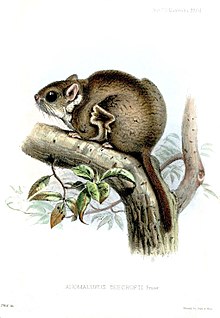Anomalure
This article needs additional citations for verification. (November 2007) |
| Anomalures | |
|---|---|

| |
| Anomalurus beecrofti, Beecroft's flying squirrel Artist: Joseph Wolf, 1851 | |
| Scientific classification | |
| Domain: | Eukaryota |
| Kingdom: | Animalia |
| Phylum: | Chordata |
| Class: | Mammalia |
| Order: | Rodentia |
| Suborder: | Anomaluromorpha |
| Family: | Anomaluridae Gervais in d'Orbigny, 1849 |
| Type genus | |
| Anomalurus Waterhouse, 1843
| |
| Genera | |
| |
The Anomaluridae are a family of rodents found in central Africa.[2] They are known as anomalures or scaly-tailed squirrels. The six extant species are classified into two genera.
All anomalurids have membranes between their front and hind legs like those of a
By extending their limbs, anomalures transform themselves into a gliding platform that they control by manipulating the membranes and tail.[4] Like flying squirrels, these species have a cartilaginous rod that aids them in maintaining the extension of the patagium when in flight; unlike flying squirrels, their cartilage originates at the elbow joint rather than at the wrist.[5]
Most anomalurid species roost during the day in hollow trees, with up to several dozen animals per tree. They are primarily herbivorous, and may travel up to 6 km (3.7 mi) from their roosting tree in search of leaves, flowers, or fruit, although they also eat a small amount of insects. They give birth to litters up to three young, which are born already furred and active.[3]
Anomalurids represent one of several independent evolutions of gliding ability in mammals, having evolved from climbing animals.[6][7] The others include the true flying squirrels of Eurasia and North America, colugos or flying lemurs of Southeast Asia, and the marsupial gliding possums of Australia.
Taxonomy
Taxonomy follows Fabre et al. 2018.[8][9]
- Family Anomaluridae
- Genus Anomalurus
- Beecroft's flying squirrel, Anomalurus beecrofti
- Lord Derby's scaly-tailed flying squirrel, Anomalurus derbianus
- Pel's flying squirrel, Anomalurus pelii
- Dwarf scaly-tailed squirrel, Anomalurus pusillus
- Genus Idiurus
- Long-eared flying mouse, Idiurus macrotis
- Pygmy scaly-tailed flying squirrel, Idiurus zenkeri
- Genus Anomalurus
Fossil genera
Several fossil genera are also known:
- Genus †Argouburus
- Genus †Kabirmys[10]
- Genus †Oromys
- Genus †Paranomalurus
- Genus †Pondaungimys
- Genus †Prozenkerella
- Genus †Shazurus
References
- ^ "Mindat.org". www.mindat.org. Retrieved 2021-06-12.
- OCLC 62265494.
- ^ ISBN 0-87196-871-1.
- ^ "Anomalure | rodent | Britannica".
- ^ Waterhouse, George Robert (27 September 1842). "Descriptions of New Species of Quadrupeds collected by Mr. Fraser at Fernando Po". Proceedings of the Zoological Society of London. 10: 125. Retrieved 9 December 2023.
- S2CID 89754034.
- hdl:1808/22093.
- S2CID 89754034.
- PMID 27602286.
- ^ Sallam, Hesham M; Seiffert, Erik R.; Simons, Elwyn L., Brindley, Chloe. A Large-bodied Anomaluroid rodent from the earliest late Eocene of Egypt: Phylogenetic and biogeographic implications. Journal of Vertebrate Paleontology 30(5):1579–1593, September 2010.
External links
- Meet the Scaly-tail Gliders Among the weirdest and most fascinating of rodents are the scalytails/scaly-tails, scaly-tailed squirrels or anomalures, properly termed Anomaluridae.
